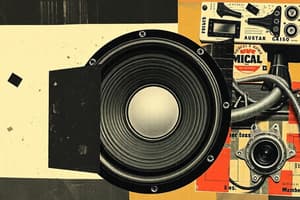Podcast
Questions and Answers
Why are filters essential in the digitalization process?
Why are filters essential in the digitalization process?
- To eliminate noise and unwanted frequencies.
- To meet the requirements of the sampling theorem. (correct)
- To convert the signal to a digital format.
- To enhance the signal's frequency response.
What is the primary function of a filter in audio engineering?
What is the primary function of a filter in audio engineering?
- Modifying the amplitude frequency response. (correct)
- Boosting specific frequencies.
- Amplifying the signal's volume.
- Creating special effects.
What is the most important criterion for differentiating between various filter types?
What is the most important criterion for differentiating between various filter types?
- The type of signal being processed.
- The frequency range of the filter.
- The application of the filter.
- The steepness of the falling edge. (correct)
Which of the following filter types is used to remove low frequencies?
Which of the following filter types is used to remove low frequencies?
Which of the following filter types allows a specific range of frequencies to pass through?
Which of the following filter types allows a specific range of frequencies to pass through?
How is the order of a filter determined?
How is the order of a filter determined?
What is the main concern regarding the use of filters in audio engineering?
What is the main concern regarding the use of filters in audio engineering?
What does the term 'dB/octave' represent in audio engineering?
What does the term 'dB/octave' represent in audio engineering?
Which filter type is commonly used in equalizers, allowing for precise frequency response control?
Which filter type is commonly used in equalizers, allowing for precise frequency response control?
What is the main difference between a semi-parametric and a fully parametric filter stage?
What is the main difference between a semi-parametric and a fully parametric filter stage?
In the context of bell filters, what does the term 'quality' (Q) refer to?
In the context of bell filters, what does the term 'quality' (Q) refer to?
Which of the following statements accurately describes the relationship between bandwidth and quality (Q) in bell filters?
Which of the following statements accurately describes the relationship between bandwidth and quality (Q) in bell filters?
What is the formula for calculating the center frequency ($f_0$) of a bell filter?
What is the formula for calculating the center frequency ($f_0$) of a bell filter?
How does a constant-Q bell filter behave with increasing gain?
How does a constant-Q bell filter behave with increasing gain?
What type of filter is designed to attenuate a specific frequency band while leaving other frequencies relatively unaffected?
What type of filter is designed to attenuate a specific frequency band while leaving other frequencies relatively unaffected?
Which of the following filter types is NOT commonly used in equalizers?
Which of the following filter types is NOT commonly used in equalizers?
Flashcards
Known filter curves
Known filter curves
Common types of filters include Butterworth, Tschebyscheff, Cauer, and Bessel, each with unique responses.
Equalizer
Equalizer
An equalizer uses various filters to manipulate frequency response, allowing precise control over sound.
Types of filters in equalizers
Types of filters in equalizers
Common filters used in equalizers include Bell, Shelf, Low and High Pass, and Notch filters.
Parametric filters
Parametric filters
Signup and view all the flashcards
Bandwidth (B)
Bandwidth (B)
Signup and view all the flashcards
Quality (Q)
Quality (Q)
Signup and view all the flashcards
Constant Q filter
Constant Q filter
Signup and view all the flashcards
Variable-Q filter
Variable-Q filter
Signup and view all the flashcards
Filter
Filter
Signup and view all the flashcards
Importance of Filters
Importance of Filters
Signup and view all the flashcards
Low Pass Filter
Low Pass Filter
Signup and view all the flashcards
High Pass Filter
High Pass Filter
Signup and view all the flashcards
Filter Order
Filter Order
Signup and view all the flashcards
dB/octave
dB/octave
Signup and view all the flashcards
Phase Frequency Response
Phase Frequency Response
Signup and view all the flashcards
Passband Distortion
Passband Distortion
Signup and view all the flashcards
Study Notes
Filters
- Filters are crucial in audio engineering, fundamental for almost all functions, and involved in most processes.
- In analog audio, they remove unwanted noise, focusing on relevant frequencies for human perception.
- Digital filters are essential for meeting the sampling theorem, enabling digital signal processing.
- Filters in digital signal processing are ubiquitous, used in almost every stage.
- The primary function of a filter is often targeted intervention in the amplitude-frequency response.
Amplitude Frequency Response
- Filters modify the amplitude strength (level in decibels (dB)) of various frequencies.
- The graph shows the amplitude changes at different frequencies; a filter is designed to reduce or enhance specific acoustic frequencies.
- A filter may reduce a frequency (attenuation) by a specified amount.
Phase Frequency Response
- Filters often affect the phase response, sometimes unintentionally.
- Changes in the phase result in waveform distortion, though distortion is not always negative and sometimes undetectable.
Filter Shapes
- Common filter shapes include:
- Low pass/High cut, Low cut filter, Bandpass, Band-stop/Band rejection, and Allpass.
- Filter steepness is critical and quantified in decibels per octave (dB/octave).
- Filter order (n) is connected to filter steepness through the equation n * 6dB/octave.
Filter Order Determination
- Filter order can be determined by locating the point on the frequency curve where the signal level drops by 3 dB.
- Then, the steepness of the edge can be used to deduce the order of the filter based on the frequency difference.
- Widely used filter profiles include:
- Butterworth
- Tschebyscheff
- Cauer
- Bessel
Equalizers
- Equalizers employ multiple filters interactively, allowing precise audio frequency adjustments.
- The curves produced to show audio output across various frequencies are the result of complex circuitry, and are not realizable with passive filters.
- Common equalizer filters include:
- Bell
- Shelf/Shelving
- Low and High Pass
- Notch Filters
Filter Parameters
-
Semi-parametric and fully parametric filters exist depending on features controlled by parameters.
-
The parameters include:
- Frequency, gain, filter quality (Q) or bandwidth
-
Bandwidth, is the frequency range between the upper and lower limit frequencies.
-
Center frequency is found using √(f1f2).
-
Filter quality (Q) is connected to the center frequency and bandwidth.
Analog Circuit Diagrams
- Fundamental analog filter forms are graphically represented via circuit diagrams, including:
- Low Pass / High Cut
- High Pass / Low Cut
- Bandpass
- Band-Stop / Band Rejection
- Analog filter designs can be applied digitally, but not every digital filter has an analog equivalent.
Studying That Suits You
Use AI to generate personalized quizzes and flashcards to suit your learning preferences.




